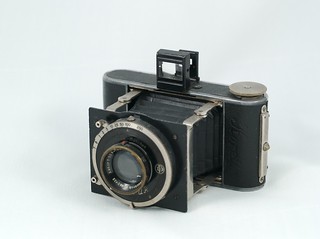Korelle strut-folding cameras
| |||||
| German, French & Italian Cameras using 127 film | |||||
| G e r m a n y |
3×4 | rigid | Dreivier | Futuro | Gewirette | Kolibri Parvola | Pupille | Ranca | Reporter | Puck | ||
| folding | Baby Ikonta | Baldi | Dolly | Goldi Gucki | Ingo | Korelle | Makinette Metharette | Perkeo | Vollenda | ||||
| 4x4 | Navax | Paxina Electromatic | Rothlar | ||||
| 4x6.5 | Bella | Billy | Bob | Dolly | Goldi Gucki | Korelle | Panta | Parvola Piccolette | Rio | Ultrix | ||||
| TLR | see German TLRs | ||||
| F r a n c e |
3×4 | rigid | Fotobaby | Lynx | Super-Boy | ||
| folding | Derby-Lux | Elax | ||||
| pseudo TLR | Auteuil | Longchamp | ||||
| 4×4 | rigid | Impera | Marly | Pari-Fex | Rubi-Fex | Top | |||
| 4×6.5 | rigid | Photo-Magic | |||
| I t a l y |
3x4 | Comet | Comet III | Cometa | Euralux Ibis | Maxima | Piccolo | Tanit | |||
| 4x4 | Comet | Euralux | Ibis | ||||
| 4x6.5 & other | Alfa | Delta | Relex | Rolet | Rondine | ||||
This page is about Korelle strut-folding cameras in 4×6.5cm, 4.5×6cm and 6×6cm formats. The 3×4cm Korelle is treated in a separate article.
The Korelle are strut-folding rollfilm cameras made by Kochmann from 1931 onwards. The name Korelle was first used on the 3×4cm model, which was followed by a full range of 4×6.5cm, 4.5×6cm and 6×6cm cameras. A 6×9cm Korelle was also released c.1934, but it was a regular folding camera, unlike the other models.
Contents
Korelle, 4×6.5cm
The 4×6.5cm Korelle, released in 1931,[1] normally takes eight exposures on 127 film. The exposure chamber is removable,[2] to mount a plate holder or a film pack holder, presumably in 4.5×6cm format.
The camera pictured below has a Japanese Zuiko 7.5cm f/4.5 lens and Koho shutter (1–200, B, T); they are not original to the camera, and were probably taken from a Semi Olympus II.
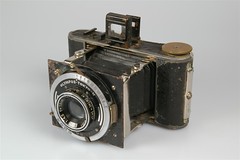  
|
| Korelle, 4×6.5cm, Zuiko 7.5cm f/4.5, Koho shutter. Pictures by Henk. (Image rights) |
Korelle P, 4.5×6cm plates
The Korelle P, released in 1932,[3] is very similar to the 4×6.5cm camera, but takes 4.5×6cm film plates or film packs only. It has square ends and lacks the round film chambers of rollfilm cameras.
Korelle, 4.5×6cm and 6×6cm
The 4.5×6cm and 6×6cm Korelle were released in 1933.[4] Their configuration is broadly similar to the 4×6.5cm model. The folding struts are mounted vertically instead of horizontally, and there is an additional door hinged at the front, to protect the lens and shutter unit. The viewfinder has a tubular shape, and is mounted on a hinged stand.
 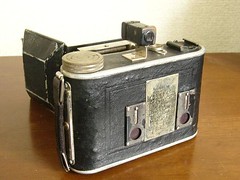
|
| Korelle, 4.5×6cm, manual film advance, Compur shutter. Pictures by eBayer Yalluflex. (Image rights) |
The 4.5×6cm model has manual film advance via a pair of red windows at the bottom of the back, protected by vertically sliding individual covers.
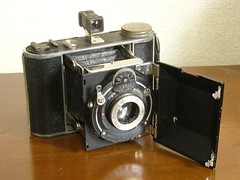 
|
| Korelle, 6×6cm, exposure counter, Vario shutter. Pictures by eBayer Yalluflex. (Image rights) |
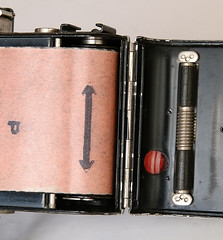
|
| Feeler roller for the film counter image by Geoff Harrisson (Image rights) |
The 6×6cm model has an exposure counter disc inside the back, graduated from 1 to 12, driven by a feeler roller. There is a small thumb-wheel in the middle for manual reset. There is a single red window at the right end, to set the position of the first frame.
It seems that the numbers for 6×6cm exposures were not printed on the paper backing of 120 film at the time, hence the need for a special exposure counter. A similar device was later adopted on the Super Makinet Six and Prince Flex 6×6cm Japanese cameras.
Notes

|
| out of McKeown: customized Korelle 6x6, see Parvola image by yalluflex (Image rights) |
Bibliography
- McKeown, James M. and Joan C. McKeown's Price Guide to Antique and Classic Cameras, 12th Edition, 2005-2006. USA, Centennial Photo Service, 2004. ISBN 0-931838-40-1 (hardcover). ISBN 0-931838-41-X (softcover). p470–1.
Links
In French:
- Korelle (4×6.5cm) at www.collection-appareils.fr
- Korelle (6×6cm) at Collection Argentique by Gérard Langlois
